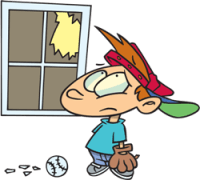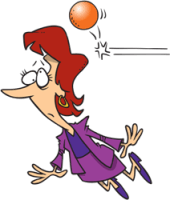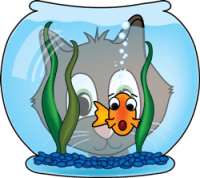English Direct Object,
Indirect Object and
Object of the Preposition
Direct Object
A direct object is a person or thing that is affected by the action of the verb. You could say that the direct object "receives the action of the verb.""He broke the window."

What was affected by the action? The window was.
So "the window" is the direct object.
"The ball hit her."

What did the ball hit? It hit her.
So "her" is the direct object.
"He is making a pancake."

What is he making? A pancake.
So "a pancake" is the direct object.
"Lucky noticed the bone."

What did Lucky notice? The bone.
So "the bone" is the direct object.
"The boy loves his father."

Whom does the boy love? His father.
So "his father" is the direct object.
"She said the right answer."

What did she say? The right answer.
So "the right answer" is the direct object.
"She gave a gift."

What did she give? A gift.
So "a gift" is the direct object.
"He got a gift."

What did he get? A gift.
So "a gift" is the direct object.

What was affected by the action? The window was.
So "the window" is the direct object.
"The ball hit her."

What did the ball hit? It hit her.
So "her" is the direct object.
"He is making a pancake."

What is he making? A pancake.
So "a pancake" is the direct object.
"Lucky noticed the bone."

What did Lucky notice? The bone.
So "the bone" is the direct object.
"The boy loves his father."

Whom does the boy love? His father.
So "his father" is the direct object.
"She said the right answer."

What did she say? The right answer.
So "the right answer" is the direct object.
"She gave a gift."

What did she give? A gift.
So "a gift" is the direct object.
"He got a gift."

What did he get? A gift.
So "a gift" is the direct object.
Additional examples (the direct object is in bold):
- Tim fixed the
computer yesterday.
- I hated that
movie so much.
- We built a
castle on the beach.
- You bought the
same hat last week.
- Joan is doing her homework right
now.
- I've made a promise.
Indirect Object
An indirect object is a person or thing that the action is done to or for.The indirect object usually comes just before the direct object.
You could also say that the indirect object is the receiver of the direct object.
"He gave his mother flowers."

To whom did he give the flowers? To his mother.
So "his mother" is the indirect object.
"He baked his family some cookies."

For whom did he bake some cookies? For his family.
So "his family" is the indirect object.
"Jack is telling them the news."

To whom is he telling the news? To them.
So "them" is the indirect object.
"Barney is writing Fred a letter."

To whom is Barney writing a letter? To Fred.
So "Fred" is the indirect object.
"She wrote me a message."

To whom did she write a message? To me.
So "me" is the indirect object.
"I made you this kit."

For whom did I made this kit? For you.
So "you" is the indirect object.
"Susan is writing herself a note."

To whom is Susan writing a note? To herself.
So "herself" is the indirect object.
"He bought his friend a present."

For whom did he buy a present? For his friend.
So "his friend" is the indirect object.

To whom did he give the flowers? To his mother.
So "his mother" is the indirect object.
"He baked his family some cookies."

For whom did he bake some cookies? For his family.
So "his family" is the indirect object.
"Jack is telling them the news."

To whom is he telling the news? To them.
So "them" is the indirect object.
"Barney is writing Fred a letter."

To whom is Barney writing a letter? To Fred.
So "Fred" is the indirect object.
"She wrote me a message."

To whom did she write a message? To me.
So "me" is the indirect object.
"I made you this kit."

For whom did I made this kit? For you.
So "you" is the indirect object.
"Susan is writing herself a note."

To whom is Susan writing a note? To herself.
So "herself" is the indirect object.
"He bought his friend a present."

For whom did he buy a present? For his friend.
So "his friend" is the indirect object.
Additional examples (the indirect object is in bold):
- Tim made Joan a sandwich for lunch.
- I told you
what to do.
- We built him
a castle on the beach.
- You bought her
the same hat last week.
- Joan is writing me a letter right
now.
- I've made Shannon a promise.
Is it a direct object or an indirect object?
How can you tell a direct object from an indirect object?Here are some tips to help you:
1) A direct object receives the action of the verb. In other words, it is directly affected by it.
2) An indirect object is the receiver of the direct object, and it usually comes just before it.
Let's have another look at some of the previous examples (the direct object is green, the indirect object is brown):
"He gave his mother flowers."

The verb is "gave."
What is directly affected by this action?
The flowers. They are given!
So "flowers" is the direct object.
Who receives the flowers? His mother.
So "his mother" is the indirect object.
You can see that the indirect object ("his mother")
is located just before the direct object ("flowers").
"He baked his family some cookies."

The verb is "baked."
What is directly affected by this action?
The cookies. They were baked!
So "some cookies" is the direct object.
Who will receive the cookies? His family.
So "his family" is the indirect object.
You can see that the indirect object ("his family")
is located just before the direct object ("some cookies").
"Jack is telling them the news."

The verb is "is telling."
What is directly affected by this action?
The news. It is being told!
So "the news" is the direct object.
Who is receiving the news? They are.
So "them" is the indirect object.
You can see that the indirect object ("them")
is located just before the direct object ("the news").
"Barney is writing Fred a letter."

The verb is "is writing."
What is directly affected by this action?
The letter. It is being written!
So "the letter" is the direct object.
Who is receiving the letter? Fred is.
So "Fred" is the indirect object.
You can see that the indirect object ("Fred")
is located just before the direct object ("the letter").
"She wrote me a message."

The verb is "wrote."
What is directly affected by this action?
The message. It was written!
So "a message" is the direct object.
Who receives the message? I do.
So "me" is the indirect object.
You can see that the indirect object ("me")
is located just before the direct object ("a message").
"I made you this kit."

The verb is "made."
What is directly affected by this action?
The kit. It was made!
So "this kit" is the direct object.
Who receives the kit? You are.
So "you" is the indirect object.
You can see that the indirect object ("you")
is located just before the direct object ("this kit").
"Susan is writing herself a note."

The verb is "is writing."
What is directly affected by this action?
The note. It is being written!
So "a note" is the direct object.
Who receives the note? She does.
So "herself" is the indirect object.
You can see that the indirect object ("herself")
is located just before the direct object ("a note").
"He bought his friend a present."

The verb is "bought."
What is directly affected by this action?
The present. It was bought!
So "a present" is the direct object.
Who will receive the present? His friend will.
So "his friend" is the indirect object.
You can see that the indirect object ("his friend")
is located just before the direct object ("a present").

The verb is "gave."
What is directly affected by this action?
The flowers. They are given!
So "flowers" is the direct object.
Who receives the flowers? His mother.
So "his mother" is the indirect object.
You can see that the indirect object ("his mother")
is located just before the direct object ("flowers").
"He baked his family some cookies."

The verb is "baked."
What is directly affected by this action?
The cookies. They were baked!
So "some cookies" is the direct object.
Who will receive the cookies? His family.
So "his family" is the indirect object.
You can see that the indirect object ("his family")
is located just before the direct object ("some cookies").
"Jack is telling them the news."

The verb is "is telling."
What is directly affected by this action?
The news. It is being told!
So "the news" is the direct object.
Who is receiving the news? They are.
So "them" is the indirect object.
You can see that the indirect object ("them")
is located just before the direct object ("the news").
"Barney is writing Fred a letter."

The verb is "is writing."
What is directly affected by this action?
The letter. It is being written!
So "the letter" is the direct object.
Who is receiving the letter? Fred is.
So "Fred" is the indirect object.
You can see that the indirect object ("Fred")
is located just before the direct object ("the letter").
"She wrote me a message."

The verb is "wrote."
What is directly affected by this action?
The message. It was written!
So "a message" is the direct object.
Who receives the message? I do.
So "me" is the indirect object.
You can see that the indirect object ("me")
is located just before the direct object ("a message").
"I made you this kit."

The verb is "made."
What is directly affected by this action?
The kit. It was made!
So "this kit" is the direct object.
Who receives the kit? You are.
So "you" is the indirect object.
You can see that the indirect object ("you")
is located just before the direct object ("this kit").
"Susan is writing herself a note."

The verb is "is writing."
What is directly affected by this action?
The note. It is being written!
So "a note" is the direct object.
Who receives the note? She does.
So "herself" is the indirect object.
You can see that the indirect object ("herself")
is located just before the direct object ("a note").
"He bought his friend a present."

The verb is "bought."
What is directly affected by this action?
The present. It was bought!
So "a present" is the direct object.
Who will receive the present? His friend will.
So "his friend" is the indirect object.
You can see that the indirect object ("his friend")
is located just before the direct object ("a present").
The Object of the Preposition
Click here if you want a review on what is a preposition.The object of the preposition is a noun or a pronoun that completes its meaning.
"The cat is
looking at the fish."


Example 1:
- She is thinking about.
Here is the complete version:
- She is thinking about your idea.
Example 2:
- Be careful with.
Here is the complete version:
- Be careful with the hot water.
Example 3:
- Emma gave the book to.
Here is the complete version:
- Emma gave the book to Ronnie.
Example 4:
- Ronnie is doing it for.
Here is the complete version:
- Ronnie is doing it for Emma.
Do not confuse the indirect object with the object of the preposition!
Have a look at the following examples:
- Emma gave Ronnie the book.
- Emma gave the book to Ronnie.
In the first sentence Ronnie is the indirect object.
In the second sentence Ronnie is the object of the preposition.
And by the way, these two sentences basically have the same meaning.
How can you tell if a word is an indirect object or the object of the preposition?
- If it comes just after a preposition – then
it's the object of the preposition.
- If it does not come just after a preposition –
then it's an indirect object.
- Also, the indirect object is usually followed by the direct object. The object of the preposition does not.
Get Updates, Special Offers, and English Resources
Download your FREE GIFT (the first two chapters of
English Short Stories Book and Workbook)
as soon as you join!

By submitting your email, you consent to receiving updates and newsletters from us and to the sharing of your personal data with third parties for the purposes of sending you communications. We will not spam you. You can unsubscribe at any time. For more information, please see our privacy policy.




